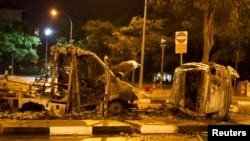SINGAPORE —
Singapore's first major riot in four decades is forcing the wealthy island to confront a stubborn but vexing question: how to treat low-paid foreign workers whose muscle underpins much of the economy but whose presence increasingly riles its citizens.<br />  <br /> Images of rioters overturning police cars, throwing garbage bins and burning an ambulance in Singapore's Little India on Sunday night shocked the orderly Southeast Asian nation and stirred debate over whether foreign workers should be better integrated or see their numbers reduced.<br />  <br /> “This is just a tip of the iceberg,” said Gayathiri, 30, an engineer who lives near the scene of the riots and goes by one name. “I hope the government will take it as a wake-up call. We need foreigners to boost our economy, but not at the expense of our security,” she added, echoing a widely held sentiment.<br />  <br /> Police charged 24 Indian nationals with rioting, which carries a maximum penalty of seven years' prison and caning. They were among an estimated 400 people who rampaged after a private bus fatally struck construction worker Sakthivel Kumaravelu, 33. The number of arrests could rise.<br />  <br /> The government has urged people not to jump to conclusions, but nonetheless many Singaporeans blame an overabundance of migrant workers and could use the riots to intensify a push for tighter immigration curbs - a step that could hurt the economy.<br />  <br /> The dominant People's Action Party (PAP), which has ruled Singapore for more than half a century, was already facing pressure over Singapore's high cost of living and its reliance on foreign workers on the island of nearly 5.4 million people.<br />  <br /> Founded by Lee Kuan Yew, the father of the current prime minister, the PAP is credited with transforming Singapore from a colonial outpost in the 1960s into a global financial hub with world-class infrastructure, safe streets, an efficient civil service and the world's highest concentration of millionaires.<br />  <br /> Part of that success is built on cheap foreign labor, which makes up nearly 20 percent of the population. Many Singaporeans have expressed concerns over a government proposal on Jan. 29 to raise the population to 6.9 million by 2030.<br />  <br /> Of that, up to 36 percent, or 2.5 million, would be made up of foreign workers to balance a low birth rate and sustain economic growth.<br />  <br /> <strong>Jobs the Locals Shun</strong><br />  <br /> Many of the current 1.3 million foreign workers do low-paid jobs shunned by locals, such as construction and domestic work.<br />  <br /> Jobs in the construction industry, for instance, are dominated by male workers from India, Bangladesh and Sri Lanka who earn a basic monthly salary of between S$460 ($370) and S$700, according to a campaign group, Transient Workers Count Too.<br />  <br /> That compares with the average Singaporean monthly wage of about S$4,433.<br />  <br /> Employers must pay a government-imposed levy on each foreign worker they wish to hire, with a higher levy for lower-paid workers to regulate their numbers. Authorities could tighten that measure to slow the influx of foreign workers.<br />  <br /> “The latest incident may further increase pressures to reduce Singapore's dependence on foreign workers,” said Chua Hak Bin, a Singapore-based economist at Bank of America Merrill Lynch. “Construction as a segment is already seeing some of the steepest levy hikes and tightening in quotas.”<br />  <br /> Others, however, argue that policymakers should focus more on the workers' welfare and integration.<br />  <br /> Many foreign workers live in crowded dormitory compounds, some housing up to 8,000 people, on the fringes of the island.<br />  <br /> “There is no policy for promoting integration. It is a separatist policy,” said Bridget Tan, the founder and chief executive of the Humanitarian Organization for Migration Economics in Singapore.<br />  <br /> In their scarce free time, many gather in Little India, an area of narrow streets and rows of shop-houses selling colorful fabrics, spices and groceries, a legacy of the 19th-century British colonial rulers who laid out the city in ethnic zones.<br />  <br /> Indians and Bangladeshis have congregated peacefully in large crowds in the area for years, eating, drinking, and illustrating decades of success in maintaining religious harmony in a polyglot community of ethnic Chinese, Malays and Indians that was convulsed by race riots in the late 1960s.<br />  <br /> Authorities banned the sale and consumption of alcohol in the area this weekend. Police stepped up patrols at foreign worker dormitories and Prime Minister Lee Hsien Loong set up an inquiry. However, some commentators say a deeper change of mind-set needs to take place.<br />  <br /> “We seem to operate on a model of wanting the foreign workforce for their labor and economic value, yet wishing they would disappear at all other times,” blogger Alex Au wrote.







